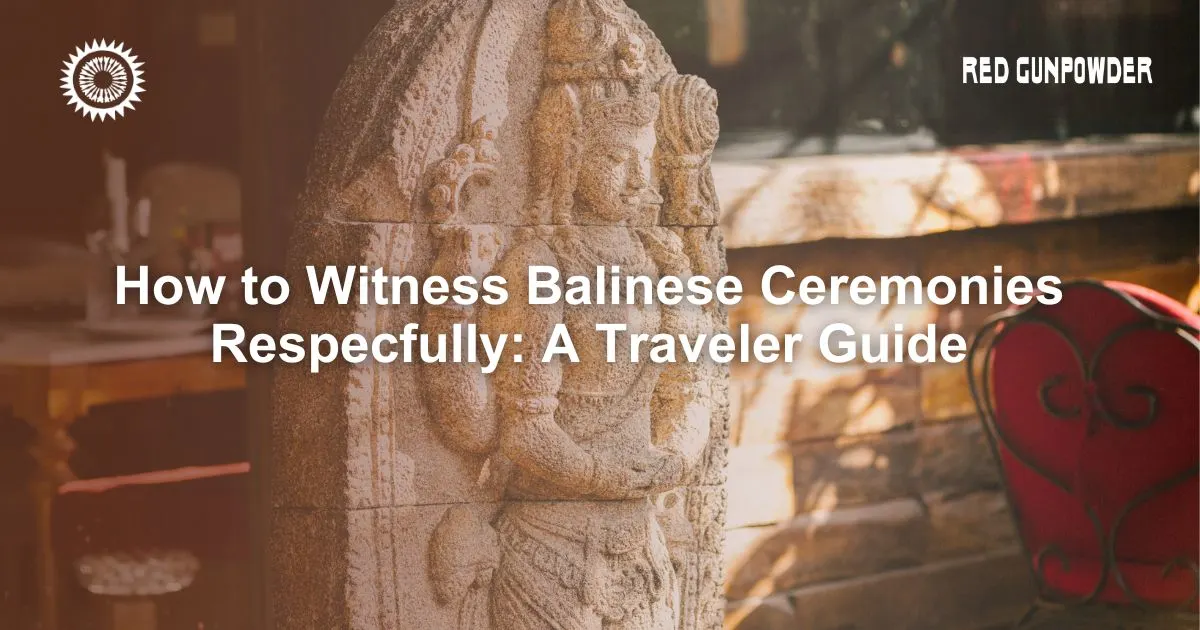As someone who’s been living in Bali for a while, I’ve learned that the island’s beauty isn’t just in its beaches or rice terraces; it’s in its spirit. That spirit shines brightest during its ceremonies, from colorful, elaborate temple festivals to quiet, gentle daily offerings laid on doorsteps. Experiencing one of these moments isn’t just about watching; it’s about truly feeling Bali’s living culture, where deep spirituality flows through every aspect of daily life.
If you’ve ever wondered how to witness an authentic Balinese ceremony respectfully and meaningfully, here is what I’ve discovered firsthand.
Table of Contents
ToggleUnderstanding the Heart of Balinese Culture: Tri Hita Karana
At the very core of every Balinese ritual is the philosophy of Tri Hita Karana, which means “Three Causes of Well-being.” This profound principle teaches the essential harmony between three elements: humans, nature, and the divine. This belief guides every offering, every traditional dance, and every prayer on the island, making every ceremony a living, breathing expression of balance, gratitude, and community connection.
You will immediately notice the daily offerings called canang sari: small, square woven baskets of colorful flowers, rice, and incense that are gently placed on doorsteps, motorbikes, and temples. These are essential gestures to honor the gods and maintain cosmic energy in balance. Beyond these daily moments, however, are larger, magnificent community-wide events that mark life’s important stages and connect people with their ancestors and gods.
Types of Balinese Ceremonies You Can Witness Respectfully
Balinese ceremonies are vibrant, diverse, and often open to respectful observation. Here are the most spectacular you can experience.
1. Odalan (Temple Anniversary Festival)
Every single Balinese temple celebrates its own “birthday,” known as an Odalan. These festivals are breathtaking spectacles that can last anywhere from one day to two weeks. The event involves massive, colorful processions, hypnotic traditional dance performances, the rhythmic, metallic sound of Gamelan music, and towering offerings that fill the air with the scent of spices and flowers. It is one of the very best ways to experience authentic Balinese spirituality in full, dazzling motion.
Where to Go: The Balinese calendar is complex, so ask locals or your accommodation about temple schedules; there is almost always an odalan happening every few days somewhere on the island. Temples in cultural centers like Ubud, Mengwi, or Tabanan often welcome respectful visitors.
2. Galungan and Kuningan
These are among Bali’s most significant and visually impactful celebrations, symbolizing the victory of good (Dharma) over evil (Adharma). During this period, the entire island transforms. You will immediately notice the tall, gracefully arching bamboo poles called penjor lining every street, each decorated beautifully with offerings to honor ancestors. Families dress in their finest traditional attire, bring elaborate offerings to the temples, and dedicate time to visiting relatives.
Best Time to Visit: This 10-day festival happens every 210 days according to the Balinese calendar, so be sure to check the specific dates before you book your trip to witness the island at its most spiritual.
3. Melasti Ceremony
A few days before Nyepi (Bali’s famous Day of Silence), you can witness the deeply moving Melasti Ceremony. In this ritual, large groups of locals walk in silent procession to the sea or a holy spring, carrying sacred temple objects for purification. It’s a breathtakingly beautiful event that symbolizes cleansing the world of negative energy, and it is open for anyone who observes with reverence and silence.
Best Spots: Large, open beaches in popular areas like Canggu, Sanur, or Mengiat (Nusa Dua) are popular gathering points for these impressive Melasti processions.
Read more: All Things You Need to Know About Nyepi or The Day of Silence in Bali
4. Ngaben (Cremation Ceremony)
This is one of the most sacred and visually powerful rituals in Bali. Known as Ngaben, it is a cremation ceremony that celebrates the soul’s joyous release into the next life. Unlike the somber funerals often seen in the West, Ngaben is colorful, filled with music, chanting, and a profound sense of celebration, rooted in the belief of transformation and rebirth.
Important Note: Due to the deeply personal nature of Ngaben as a family event, you should only attend if you are formally invited or if you are guided by a trusted local who can facilitate your respectful presence.
5. Traditional Rites of Passage
If you are lucky enough to be invited, witnessing local events like a traditional wedding or a Mepandes (Tooth-Filing Ceremony) offers a rare glimpse into Bali’s vibrant community life. Mepandes, a coming-of-age ritual, involves symbolically filing the teeth to remove negative traits like greed or anger. These smaller ceremonies are alive with traditional music, elaborate food, and powerful symbolism, showcasing Bali’s strong sense of collective identity.
How to Join or Observe Respectfully: Essential Etiquette
Your presence is generally welcome, but demonstrating respect is non-negotiable.
- Dress Modestly: You must wear a sarong and a sash when entering any temple (pura). You can easily borrow or buy these traditional coverings at most major temple entrances.
- Ask Permission: Always check with locals or temple guards before taking photos or moving into the main ceremony area. Most people will gladly welcome you if you ask politely and show humility.
- Observe, Don’t Interrupt: Stay quietly behind the main participants, avoid blocking pathways (especially the inner courtyards), and remain completely silent during moments of prayer. Do not walk in front of a worshipping Balinese person.
- Go with a Local Guide: Hiring a cultural guide or joining a local friend helps you immensely, not only in navigating the event but also in truly understanding the deeper, complex meaning behind the rituals.
- Bring an Offering (Optional): You can buy a small canang sari at a local market to place respectfully near the temple entrance; this is a simple, beautiful gesture of gratitude for being allowed to witness their sacred space.
Where to Find Authentic Ceremony Experiences
While ceremonies happen everywhere, certain areas offer an especially rich cultural immersion:
- Ubud: This is the spiritual and cultural heart of Bali, where ceremonies beautifully blend art, traditional dance, and deep devotion.
- Pererenan: A growing coastal cultural hub where traditional, daily rituals still happen actively amid the modern, chic village life.
- Sidemen & Tabanan: These areas are ideal for travelers who seek authentic, intimate, and less touristy ceremonial experiences deep within the rice paddies.
Read also: Sacred Balinese Symbols and Their Meaning You Should Know
Frequently Asked Questions about Balinese Ceremonies
Can tourists attend Balinese ceremonies?
Yes, most community and temple ceremonies, like odalan, are open to respectful visitors. The key is to dress appropriately, follow all local customs, and maintain a quiet, respectful presence.
Do I need an invitation to enter a temple during ceremonies?
For large temple festivals (odalan), visitors are generally welcome. For deeply personal family ceremonies (like weddings or Ngaben), it is always best to be personally invited or go accompanied by a knowledgeable local guide.
Can I take photos?
Only if it is clearly permitted by the local host or temple guide. Avoid using flash, and never, ever take photos during the actual prayer moments or inside the most sacred inner sanctuaries of the temple.
What should I wear?
You should wear a sarong, sash, and a modest top that covers your shoulders and arms. These items can be easily rented or purchased near most major temple sites.
When is the best time to see ceremonies in Bali?
Major ceremonies like Galungan, Kuningan, and Nyepi happen twice a year (every 210 days). However, thanks to the intricate Balinese calendar, smaller community and temple ceremonies occur almost daily all across the island.
Final Thoughts
Witnessing a Balinese ceremony isn’t about ticking a box on a tourist list; it’s about genuine connection. It’s a chance to slow down, breathe in the evocative scent of incense, and understand how deeply spirituality is woven into daily life here. From the rhythmic sound of gamelan to the calm, beautiful smiles of the locals, every ceremony reminds me that Bali’s true beauty lies not just in what you see, but profoundly, in what you feel.
So when you visit, don’t just look for stunning temples; look for moments that touch your heart. Those are the authentic Balinese ceremonies you will never forget.






